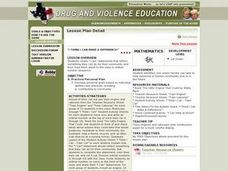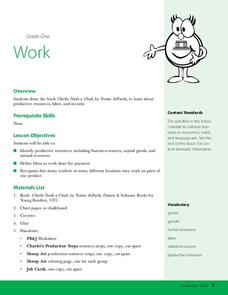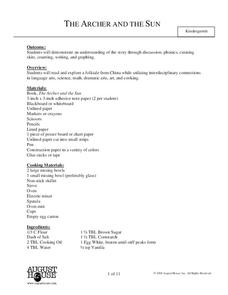Curated OER
How Many Lemons Does It Take?
Students discuss and explore different methods that can be used to estimate from the video. They practice estimation skills by recreating a sample problem from the video. Web sites containing other estimation activities are included
Curated OER
Let it Grow, Let it Grow, Let it Grow
Students investigate, through a hands-on activity, in which type of soil a bean seed grows best. They create a bar graph representing each plant's growth in different soils.
Curated OER
Comparing Sizes And Shapes
Students compare, resize, and check various shapes by size using a comparison mat from the MathKeys program. Working in pairs, they place three similar shapes on the screen and state which is the largest and smallest in area. They also...
Curated OER
Modular Arithmetic on the Planet of the Eights
Students explore modular arithmetic involving base eight. They participate in an activity where society functions around the numbers one through eight. Students explain how life will operate with only these numbers.
Curated OER
Measurement
First graders participate in various activities dealing with measurement, length, volume, and temperature. They identify the need for standard units of measure, sort and classify objects, measure distances, and use a thermometer.
Curated OER
Record 'The' Results
Third graders predict how many times they'll see the word "the" in a newspaper page and highlight all the "the"s they find. After reviewing definitions of range, median, mode, mean they create a Stem and Leaf Plot and a Back-to-Back Stem...
Curated OER
What Does Greatest Common Factor Mean to Me?
Learners see a demonstration of the concept of factors through modeling. They do an activity that help them explain further the concept of common factors and greatest common factor.
Curated OER
Slope Calculation
Middle schoolers practice calculating the slope of a line. They explain how the formula is derived and identify properties that are associated with positive, negative and undefined slopes. They complete an online activity as well.
Curated OER
I Think I Can Make a Difference!
First graders write "I Can" statements to tell what they can do to help their community. They write the statements on a train car that has a number written on it. They share their statements in order of the number of their train car...
Curated OER
Forces Applied to an Object
Fourth graders predict, observe, and compare what happens when a force is applied to an object. In this forces lesson, 4th graders complete a 'swinging hammer' activity to learn about forces and motion.
Curated OER
Morphemic Analysis
Students analyze content area vocabulary. In this content area literacy lesson plan, students list math words they are unfamiliar with and identify morphemes found in those words that are found in other words. Once they have a list of...
Curated OER
That's Entertainment
Second graders view examples of active lifestyles in works of Robert Harris, and list and graph their daily activities to see if they lead active lifestyles. Students then name forms of entertainment that require practice,...
Curated OER
Teddy Bears Everywhere
Students explore the history of teddy bears. In this comprehension lesson, students bring a bear of their own to compare and contrast with their classmates. Students read book and discuss the events and draw pictures of the scenes.
Curated OER
Work
Learners identify productive resources. In this economics instructional activity, students read the book Charlie Needs a Cloak and discuss productive resources the character used in the book. Learners participate in a simulated factory...
Curated OER
Beautiful Bugs
Students investigate the life cycle of ants, ladybugs, and butterflies. They list the four stages of the butterfly life cycle, define symmetry and observe how ants make homes in dirt.
Curated OER
We Are Reflections of Canada - Our People, Our Places, And Our Landscape
Sixth graders discover that they are active participants in Canadian culture. They engage in investigation of the past and various symbols of Canada. They explore their concept of culture and demonstrate an understanding of culture...
Curated OER
Stone Fox
Students use the book, Stone Fox, to explore income, capital, saving, taxes, and credit. Stone Fox tells the story of Little Willy, a ten year old who enters a challenging dog-sled race in hopes of winning money to pay the back taxes on...
Curated OER
Hurricanes and Tornadoes (Grade 4-8)
Learners investigate the concepts of hurricanes and violent weather conditions. In this violent weather lesson, students access an Internet site and watch a video about how air masses behave, how a tornado forms, how hurricanes form, and...
Nemours KidsHealth
Eating Disorders: Grades 3-5
Explore the idea of self-esteem through different mediums. Research what is needed for increased self-esteem: list three things one might do well in, take a photo of an activity where each student is performing well, and examine how the...
Curated OER
Fish Count
In this science worksheet, students read about how scientists determine the total number of fish in a population. Students also participate in a related math activity.
Curated OER
The Mathematical Implications of Lying
Students explore how statistics can be interpreted in different ways. In this probability lesson students complete a class lab activity then discuss their findings.
Curated OER
The Archer and the Sun
Students listen to The Archer and the Sun and participate in interdisciplinary activities related to the book. In this Archer and the Sun lesson, students discuss sun and weather and create a graph of the weather they like best- sunny or...
Curated OER
Why Koala Has A Stumpy Tail
First graders read the story Why Koala Has A Stumpy Tail and complete language arts activities with it. Students have discussions, read, write, spell, and act out the story.

























